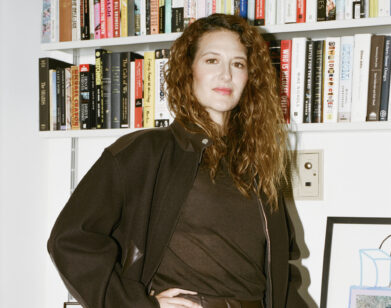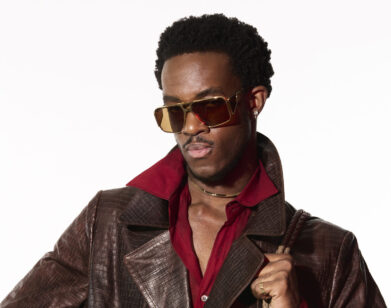Laure Heriard Dubreuil

ABOVE: LAURE HERIARD DUBREUIL AT STUDIO ASTRE, PARIS, JANUARY 2013
People are more interested now in showing their own fashion sense and expressing their own style without copying an entire look from an ad campaign.Laure Heriard Dubreuil
LOCATION: 1220 Collins Avenue, Miami Beach. HISTORY: Heriard Dubreuil, whose family runs the Rémy Martin cognac house, studied at FIT in New York and worked for Balenciaga and Yves Saint Laurent in Paris. She decamped for South Beach in 2007 to co-found the Webster with friends Milan Vukmirovic and Frederic Dechnik in a renovated Art Deco building, and the store’s razor-sharp edit of fashion and accessories has almost singlehandedly helped style-ify bikini-centric Miami. CURRENT OBSESSION: “We’re carrying an exclusive dress by Nomia from a collaboration capsule with Nate Lowman—it has a snake embroidered in front, is all made in New York, and very sexy in an artsy, Brooklyn way.” â??WHERE SHE LIKES TO SHOP: â??“Rondini for sandals in St. Tropez—they’re an example of true craftsmanship, they’re extremely chic, and I cannot get enough of them and can only find them there. I also like vintage shopping in San Francisco, which is the source for great ’70s pieces, as well as at the Grand Bazaar in Istanbul, which never ends. I am also a huge fan of C. Madeleine’s in Miami Beach, and for lace pieces, the Sunday flea markets in Buenos Aires.”
INTERVIEW: Why open the Webster—and why in Miami?
LAURE HERIARD DUBREUIL: I always say I opened the Webster in Miami because of the rainy weather in Paris. But really—apart from my love for Miami and its weather—we opened the store there because I came to Art Basel Miami Beach once from Paris, and needed a few additional pieces to complete my looks, but I couldn’t find anything to buy anywhere, so there really was a gap to fill. Miami is also the gateway to South America, which has a very affluent Brazilian population, among others.
INTERVIEW: How do you think the Webster’s location has affected the way the store has evolved and developed?
LAURE HERIARD DUBREUIL: I think being based in Miami has made a huge difference in speeding up the “fame” process. Miami is a city that a lot of people pass through one way or another, whether they’re on their way to South America or the Bahamas, or escaping for a warm weekend away from New York, or coming for vacation for six months. We have people coming from everywhere in the world. South Americans, Europeans, a big Russian community, R&B singers, NBA players, athletes—they all come to Miami to enjoy the weather, to record an album, to play for the Miami Heat . . . But Art Basel has also helped us a lot, since for one week in December, you have the most refined and sophisticated crowd in the world, and they’ve spread the word. At first, people were intrigued—skeptical even—about the idea of a store like this in Miami, especially in South Beach. And now we also have clients from everywhere in the world who have not even set one foot inside the Webster, or have even come to Miami, but have discovered our selection through press or word of mouth. The seasonal component is affecting us less and less as Miami is becoming more and more “trendy” all year long.
INTERVIEW: How do you handle the buying for the store?
HERIARD DUBREUIL: I curate the entire store, and the way it keeps evolving is through my extensive research, immersion in the fashion world, and travels. I’m always looking for new collaborations and new brands that have the Webster DNA: timeless yet remembered. Each piece is approved and selected by me, but my team weighs in, of course, and I need feedback from our clientele. What I try to bring every season to the Webster is a mix of pleasure and discovery—pieces that are not found everywhere. The business model is to create your absolute dream closet. It is always curated, not just stock or inventory. The commerce side is for me to follow my taste and my instincts, yet measure the risks and get the team’s input. Working on special collaborations with designers is always so enriching and exciting. The Target collaboration we did was a real-life American Dream—designing 250 pieces for 1,500 stores. There’s also the fact that so many of the designers I carry have come to the Webster and fallen in love with it, like Alber Elbaz or Monsieur Valentino himself. These are moments that build the soul of the store.
INTERVIEW: How has the way that people shop changed in the last decade?
HERIARD DUBREUIL: People have not changed. The media and its love for the fashion world behind the scenes has changed, giving people more access to changing tastes and opinions everywhere. There has been a shift in the last few years, with the new exposure of personal styles on blogs and Instagram and websites, so people are more interested now in showing their own fashion sense and expressing their own style without copying an entire look from an ad campaign. Because of that, stores need to move toward more personal edits and styling. We make it easier for people, as we’ve already preselected. On a global picture, if you look at the evolution of the shopping business model, many consumers tend to ask for faster shopping, which explains why e-commerce is so successful. I think the fashion clients will be more and more demanding of uniqueness and mix, match, and create-your-own-look silhouettes, as opposed to head-to-toe designers looks. Limited collections are very important, in my opinion. They put ready-to-wear at a different level, and they create pleasure and individuality.
INTERVIEW: Are your interested in opening up other Websters in the future?
HERIARD DUBREUIL: Yes, I’ve always wanted to open other locations. It totally makes sense, and I could cater and modify my selection and play on the seasons by having several locations. Most of our clients travel a lot, and they often ask for a Webster in New York City, Paris, Rio. I learned Mandarin for eight years, so why not opening in Shanghai one day? Many people who love the Webster are not able to come to Miami, but maybe The Webster could come to them?
For more fashion and culture curators, click here.






